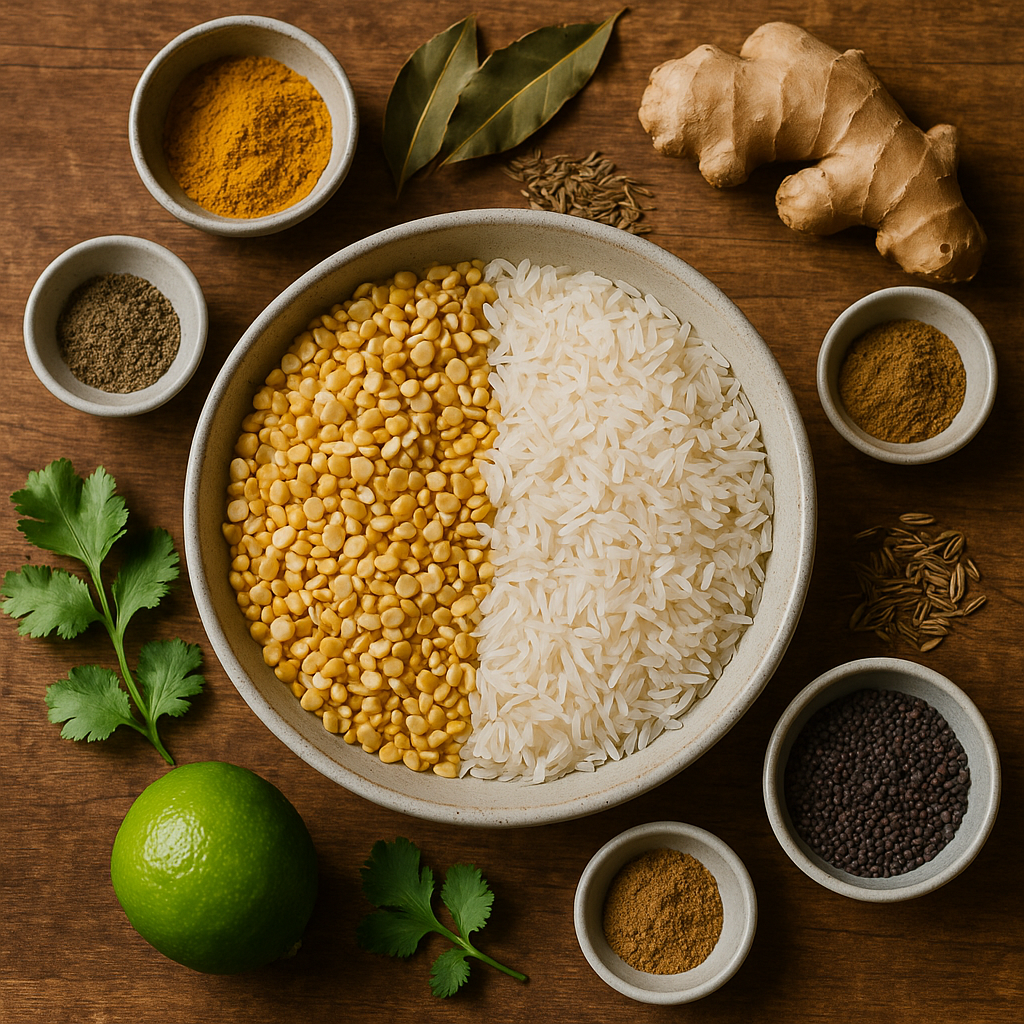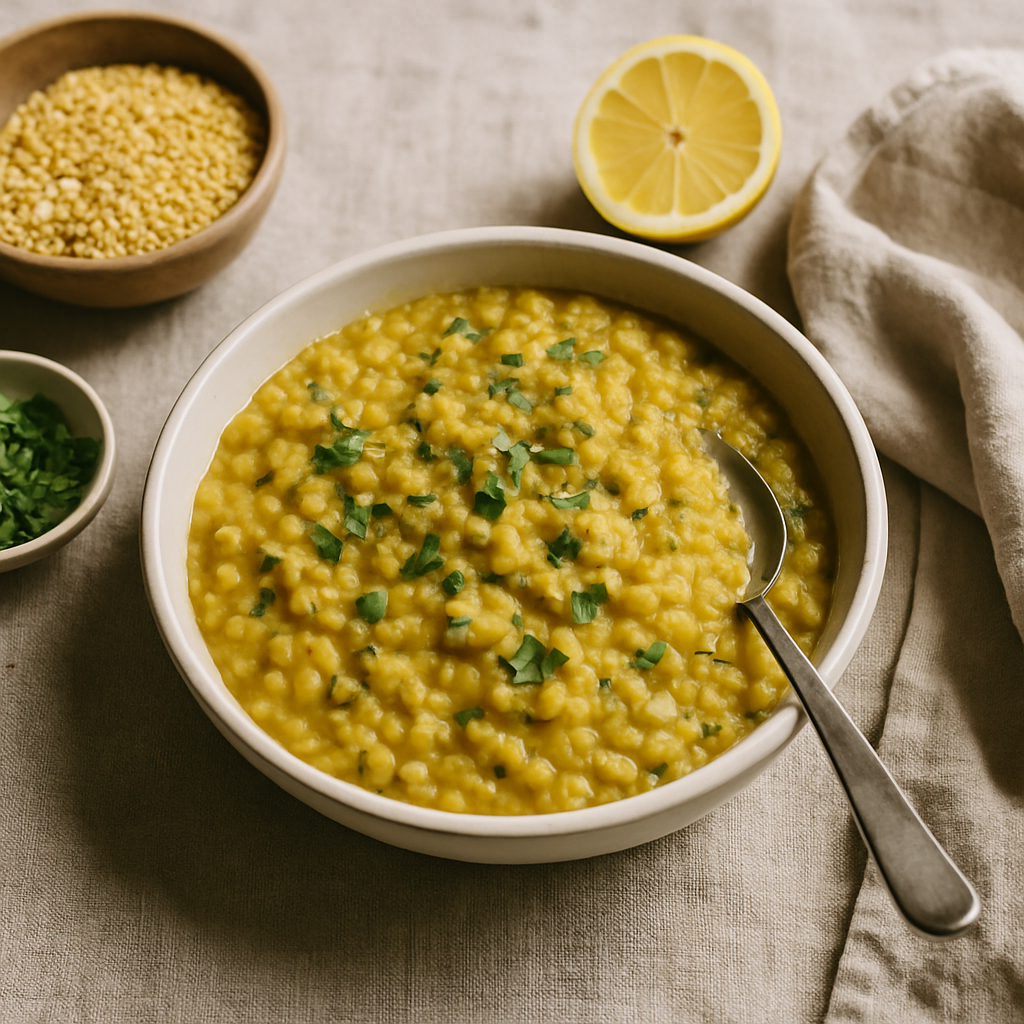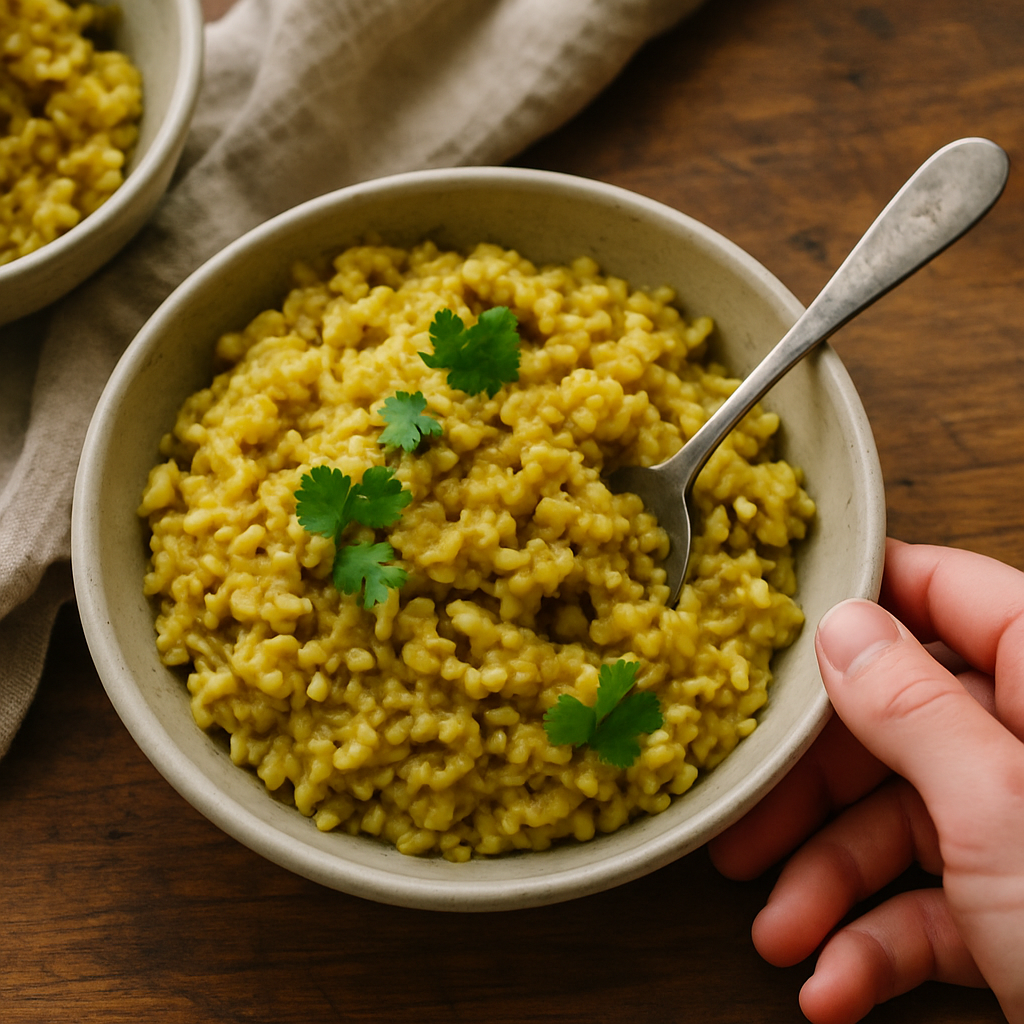Ask Ayurvedic doctor a question and get a consultation online on the problem of your concern in a free or paid mode. More than 2,000 experienced doctors work and wait for your questions on our site and help users to solve their health problems every day.
Shop Now in Our Store
How to Make Kitchari: Ayurvedic Recipe, Ingredients, and Benefits

If you've ever Googled how to make kitchari, you're probably looking for more than just a quick dinner idea. Kitchari is no ordinary dish—it’s deeply rooted in Ayurvedic tradition, designed not only to nourish your body but also to balance your energy. Whether you're craving comfort food or starting a gentle cleanse, this warm, mushy, spice-kissed blend of rice and lentils might just be the answer.
In this guide, we'll explore the history and healing power of kitchari, go over a practical kitchari recipe, and break down the kitchari ingredients that make this dish so popular in holistic circles. You’ll also discover how to customize it based on your dosha, and why it’s a staple in Ayurvedic detoxes. Let’s dive into the simple kitchari recipe that’s been healing bodies for centuries.
What Is Kitchari in Ayurveda?
Kitchari Meaning and History in Ayurvedic Tradition
Kitchari (sometimes spelled khichdi or kichari) comes from the Sanskrit word “khicca,” which loosely translates to a mixture, usually involving grains and legumes. In the context of kitchari Ayurveda, the dish is more than just a meal—it's a therapeutic food, often served during illness or spiritual fasting.
This ancient porridge-like meal has been a staple in Ayurvedic cooking for thousands of years. The basic kitchari rice and dal combo provides all nine essential amino acids, making it a complete protein. It's gentle on the digestive system and can be eaten during periods of illness, post-surgery, or during the Ayurvedic detox program called Panchakarma.
Why It’s Considered a Healing Food
So why is kitchari so highly regarded in Ayurvedic medicine? It's simple, really. The combination of mung dal (split yellow lentils) and basmati rice, cooked with healing spices like cumin, ginger, and turmeric, creates a meal that is incredibly easy to digest. This means your body can absorb nutrients without spending a ton of energy on digestion. Plus, kitchari’s warm, soupy consistency is soothing, especially during seasonal transitions or stressy times.
Kitchari also helps "reset" the digestive fire, or agni, which is considered essential in Ayurveda for maintaining health. A sluggish or irregular agni can lead to a buildup of ama (toxins), so eating ayurvedic kitchari helps stoke the flame and remove that internal junk.

Kitchari Benefits According to Ayurveda
There are a lot of reasons why people turn to kitchari when they want to feel better. First, it’s highly sattvic, meaning it promotes clarity, calm, and peacefulness. That makes it ideal for meditation retreats, cleansing protocols, or even just as a grounding dinner after a chaotic day.
Some of the most praised kitchari benefits include:
-
Digestive reset: Great for gut health and restoring healthy bowel function.
-
Detox support: Often used in Ayurvedic detoxes because it's nourishing and cleansing.
-
Customizable nutrition: It’s super easy to tweak the recipe depending on your dosha or what your body needs.
-
Balanced energy: Unlike raw diets or juice fasts, kitchari keeps your energy steady without spiking or crashing.
That being said, some people may get bored of it quickly—especially if they try eating it for every meal during a cleanse (which...is a bit much, let’s be honest).

Kitchari Ingredients and Preparation Guide
Essential Ingredients
A good ayurvedic kitchari recipe doesn’t require anything fancy, but each ingredient plays a purpose. Here’s what you’ll usually need:
-
Basmati rice – Easy to digest and calming to the system. This is the main kitchari rice used.
-
Split yellow mung dal – Light, nourishing, and excellent for balancing all doshas.
-
Ghee – Adds a buttery richness and helps deliver the medicinal qualities of the spices deeper into the tissues.
-
Cumin, coriander, turmeric, ginger – The spice quartet. These herbs boost digestion and reduce inflammation.
-
Water or broth – For the base; more water makes it soupier, less makes it thicker.
-
Vegetables (optional) – Carrots, zucchini, spinach, etc., depending on your dosha.
The magic of a simple kitchari recipe is that you can easily build on it. Add fresh cilantro, lemon juice, or toasted mustard seeds at the end for a flavor lift. Or not—some days, bland is what the doctor ordered.
Dosha-Specific Adjustments (Vata, Pitta, Kapha Variations)
In Ayurveda, every person has a unique mind-body constitution known as a dosha—Vata, Pitta, or Kapha. Kitchari can be easily adapted to support each one, which is part of what makes it so versatile.
-
For Vata (cold, dry, and light): Use a bit more oil or ghee, and go easy on the spices. Add warming ingredients like ginger, cinnamon, and asafoetida. Cook the kitchari a little longer until it’s super soft and mushy. Root veggies like carrots and sweet potatoes are ideal here.
-
For Pitta (hot, sharp, and oily): Avoid too much spice—especially chilies or black pepper. Use cooling herbs like cilantro and fennel seeds. Add more water so the texture is soothing. Bitter greens like spinach and zucchini help balance excess heat.
-
For Kapha (heavy, slow, and damp): Go easy on the ghee and rice—use more dal and add plenty of warming, pungent spices like mustard seed, turmeric, and black pepper. Lighter veggies like kale, cauliflower, and leeks are great for cutting through that Kapha density.
These tweaks don’t require a nutrition degree—they're easy and intuitive once you get used to listening to your body. Plus, you don’t need to get obsessive about it. If you mess it up a bit, no big deal.
Herbs and Add-ins for Enhanced Nutrition
Want to take your ayurvedic kitchari to the next level? There’s no shortage of ways to boost it with extra goodness:
-
Fresh herbs: Cilantro (cooling), parsley (detoxifying), basil (warming).
-
Digestive aids: Asafoetida (hing), fennel, ajwain seeds.
-
Superfoods: Add soaked quinoa or amaranth for a protein kick.
-
Greens: A handful of spinach or kale near the end of cooking adds iron and fiber.
-
Medicinal add-ins: A scoop of triphala powder (though not for taste...) or a dash of castor oil in serious detox cases—but this is best done with guidance from an Ayurvedic practitioner.
There’s no rulebook—just build from the base and add what feels right, or what your body’s asking for that day.

Step-by-Step Ayurvedic Kitchari Recipe
How to Make Kitchari at Home
Now the good stuff—the actual method. This kitchari recipe is beginner-friendly and can be adjusted for your tastes or dosha.
Basic Recipe:
Ingredients:
-
1/2 cup basmati rice
-
1/2 cup split yellow mung dal
-
1.5 tbsp ghee
-
1 tsp cumin seeds
-
1 tsp mustard seeds (optional)
-
1 tsp turmeric
-
1 tbsp grated fresh ginger
-
4–5 cups water (adjust for desired thickness)
-
1.5 cups chopped vegetables (optional)
-
Salt to taste
-
Fresh herbs for garnish (cilantro or parsley)
Instructions:
-
Rinse the kitchari rice and mung dal thoroughly in cool water (until the water runs clear).
-
In a large pot, heat ghee. Add cumin, mustard seeds, and ginger. Let 'em sizzle for 30 seconds.
-
Add turmeric, then stir in rice and dal. Toast for 1–2 minutes.
-
Add water and bring to a boil. Reduce heat and simmer for about 30–40 minutes, stirring occasionally.
-
Toss in veggies during the last 10–15 minutes. Add salt to taste.
-
Top with fresh herbs or a squeeze of lemon. Serve warm.
Honestly, you can’t really mess this up. If it turns out too soupy? Great. Too thick? Add more water. Kitchari’s forgiving like that.
Simple Kitchari Recipe for Beginners
If the full recipe above feels a bit much, here’s a stripped-down version that still hits the spot:
Quick Version:
-
1/2 cup rice
-
1/2 cup mung dal
-
1 tsp turmeric
-
1 tsp cumin
-
1 tbsp ghee
-
Pinch of salt
-
4 cups water
Boil, simmer, stir occasionally, and done. In about 30–35 minutes, you've got yourself a bowl of comfort and balance. No frills, just function.
Cooking Tips for Texture, Flavor, and Digestibility
-
Soak the dal for 20–30 minutes before cooking—it cuts cooking time and makes it even easier to digest.
-
Stir every so often to keep the texture creamy and avoid burning at the bottom.
-
Don’t over-salt; the spices should do the heavy lifting.
-
Add lemon juice or a pinch of black salt at the end for a little brightness.
Mistake #1 here might be using the wrong kind of dal—don’t use whole green mung beans if you want authentic texture. It’s split yellow mung dal you’re after. Sounds nitpicky but actually makes a difference.

How to Eat Kitchari for Wellness
When and How to Include It in Your Daily Diet
You don’t need to be on a detox to enjoy the perks of kitchari. In fact, many people in India and increasingly in the West are eating it regularly as part of a balanced, mindful lifestyle. It’s gentle enough for breakfast, nourishing enough for lunch, and grounding enough for dinner—though you probably wouldn’t eat it every single day forever. (Well, some do. But that’s maybe a bit...extreme.)
You can start by having kitchari once or twice a week, especially during seasonal changes or if you're feeling a bit off—sluggish digestion, low energy, poor sleep, all those signs your system needs a reset. Ayurveda says food is medicine, and ayurvedic kitchari is like the chicken soup of Ayurvedic cooking: soothing, simple, and safe for almost everyone.
For digestion support, eat it warm (never cold!), chew slowly, and pair with herbal teas like cumin-coriander-fennel or ginger tea. Eat until you’re about 75% full. And yeah, that part’s hard. Kitchari tastes better than you'd think.
Kitchari for Panchakarma and Cleansing Protocols
If you’ve ever researched Ayurvedic cleansing, you’ve probably heard of Panchakarma. This isn’t your average juice cleanse. It’s a deeply personalized detox that can include massage, steam therapy, enemas (yep), and of course, lots and lots of kitchari.
During Panchakarma, kitchari becomes the main food because it’s:
-
Tridoshic (balances all three doshas)
-
Nutrient-dense but super light
-
Easy to digest, even for weakened systems
It acts as a carrier for herbs and helps draw toxins from the tissues. People often eat it exclusively for several days or even weeks during the cleanse. If you're just trying it out at home, a simple kitchari cleanse for 1–3 days can be a gentle reset—nothing drastic, just nourishing and grounding.
One word of warning: Don’t do a full Panchakarma at home without a trained Ayurvedic practitioner. It’s tempting, sure, but kitchari alone won’t handle the deeper stuff if you're truly toxic.
Combining Kitchari with Herbal Teas and Rest
Ayurveda isn’t just about what you eat. It’s also about how you live. If you’re planning to use kitchari as part of a wellness protocol, pair it with:
-
Herbal teas: CCF tea (cumin, coriander, fennel), ginger tea, or tulsi for calming.
-
Rest: Go to bed earlier, take naps if you’re tired. Your body will thank you.
-
Digital detox: Reduce stimulation so your body can focus on healing.
-
Self-care rituals: Try dry brushing, oil massage (abhyanga), or simply slowing down.
In short, give your body a break—and a bowl of warm, healing food.
Conclusion
If you were wondering how to make kitchari, now you’ve got not just the recipe, but the context, the reasons, the tips, and even the soulful little rituals that go with it. Kitchari is more than food—it’s a tool for balance, healing, and simplicity in a cluttered world.
By tuning into your dosha, choosing your kitchari ingredients wisely, and cooking with intention, you’re not just feeding yourself—you’re supporting your entire being. And hey, it’s delicious. Especially with a dollop of ghee on top and that sprinkle of fresh herbs.
Whether you’re diving into a detox, starting a mindfulness practice, or just craving something that feels like a hug in a bowl, the kitchari Ayurveda approach has something to offer.
Give it a try. Maybe share it with a friend. And don’t forget to listen to your body—it knows what’s up.
FAQs
Can kitchari be eaten every day?
Yes, technically it can. It’s safe, nourishing, and balancing. But variety is also key in a healthy diet, so don’t be afraid to mix things up now and then.
Is there a difference between detox kitchari and regular kitchari?
Not much in terms of ingredients, but detox kitchari is usually lighter—less salt, less ghee, more water, and fewer spices. It's tailored for cleansing rather than comfort.
How do I make kitchari more suitable for my dosha?
Adjust the spices, oil, and vegetables. For example, Vata types need more warmth and oil, Pitta needs cooling herbs and milder spices, and Kapha does best with light, spicy, and dry textures.
What kind of rice and dal are best for kitchari?
Always go for basmati rice and split yellow mung dal. They’re easy to digest and ideal for all doshas. Other types can be used, but they may change the dish's qualities.
If this guide helped you understand the magic of kitchari, share it with someone who's curious about Ayurveda or wellness cooking. Or better yet—cook a batch and invite a friend over. Healing is better when it’s shared. 🌿
This article is checked by the current qualified Dr Sujal Patil and can be considered a reliable source of information for users of the site.

